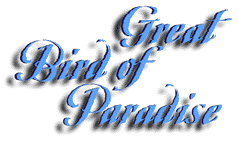

The bird of paradise is closely
related to the bowerbird and crow and belongs to the family Paradisaeidae. There are 43 species, 35 of which are confined to New Guinea. There are 3 species in the Moluccas and several species of the less spectacular riflebirds in eastern Australia. Spaniards in the 16th century coined the name bird of paradise when magnificent bird skins were brought to Europe aboard Magellan's ship, Victoria.
These remarkably beautiful birds are about the size of a crow. They have strong feet adapted for perching, and bills of various shapes. The trailing plumes, short velvet-like feathers and beautiful collars are used by the male in their courtship dance. The females, in comparison, are very plain. The males have established territories where they dance for the females. The dances are as remarkable as the birds. Perched on a branch, the birds sway and crouch or stand erect, tilt forward and backward, some even hang upside down. Every species has its own type of dance.
Birds of paradise live in forests and frequent the high treetops or lower scrub. The open nest is built in tree branches and sometimes in holes. The female handles nest-building, incubation of the one or two eggs that are orange streaked with brown, and raising the young. The males are polygamous. Their diet consists of insects, worms, small vertebrates and also fruits and seeds. The voice is quite plain. The best known and most beautiful are the members of the genus Paradisea. The Great Bird-of-Paradise, Paradisea apoda, of Aru is a rust reddish brown on the back, the head is yellow, the throat is emerald-green. It has long tufts of golden-orange feathers on the sides. The two elongated central tail feathers are very thin. When courting it spreads its wings and hangs upside down.
Iridescent breast shield, golden whiskers, and six wirelike crown plumes mark a Carola's parotia, a rarely seen bird of paradise.
Count Raggi's bird of paradise (Paradisaea raggiana) is found in the rain forests of Papua New Guinea, is known for its wild and frenzied dances done to court the drab females. Its coloration is firey red, yellow head and green around the bill and a dark throat.



